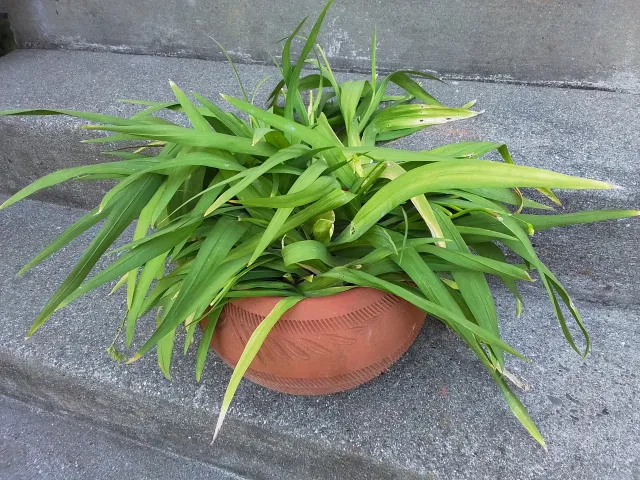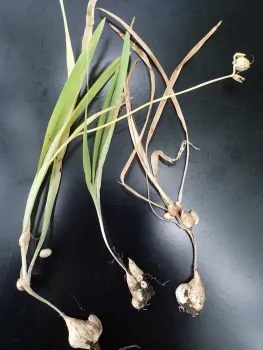Blog by Patricia Matteson
You’re looking at a sorely overgrown, post-bloom pot of freesias, crowded by three years of self-propagation via cormels that sprout from the main corm or develop at the base of leaves. Once the plants in this pot entered summer dormancy, I set out to dig up the corms for replanting at proper spacing. The soil turned out to be packed with cormels, which got bigger as I dug deeper. To my surprise, I found the few large mother corms, originally planted an inch or two below the soil surface, at the very bottom of the pot. They had moved.

Since then, I’ve discovered the explanation of that mystery. Too-shallow bulb planting may be corrected by the flowering bulbs themselves! This should greatly comfort lazy gardeners like me, who tire when having to dig a lot of deep planting holes, and so are tempted to plant bulbs at a shallower depth than is optimal. More than 400 plant species from many different families, including garden stalwarts such as tulips, daffodils, lilies, crocuses, dahlias, and gladiolas, can move downward in the soil under their own steam, so to speak, to reach more favorable growing conditions.
Steam doesn’t actually enter into it, but water does. The movement of bulbs is powered by a hydraulic shift in the outer cell layer of specialized contractile roots, which are more robust than the fibrous roots that transport water and nutrients. Bulbs, corms, tubers, and rhizomes may all grow contractile roots. Sunlight penetrating the soil is known to stimulate the contractile roots of some plants. The base of the root shrinks, becoming wrinkled like a deflating accordion, while its lower end clings to the deeper soil. Slowly—depending on soil conditions, it could be a fraction of an inch per year--the bulb is pulled downward toward its proper soil depth.
From now on, I won’t feel so guilty about possibly shortchanging newly-planted bulbs. Not only that, but I am noticing that gladiolas planted three years ago no longer fall over under the weight of their blossoming flower stalks. I suspect that they’ve become steadier because they’ve gone deeper!

Selected references
American Society for Horticultural Science. 2007. "'Smart' Flower Bulbs Pull Themselves To Deeper Ground." ScienceDaily, 10 December. https://www.sciencedaily.com/releases/2007/12/071203094826.htm .
Winship, L. J. Published in print 5/11/13. “Burrowing Bulbs—Plants That ‘Plant’ Themselves.” Earth Matters, Hitchcock Center for the Environment | Education for a Healthy Planet.

